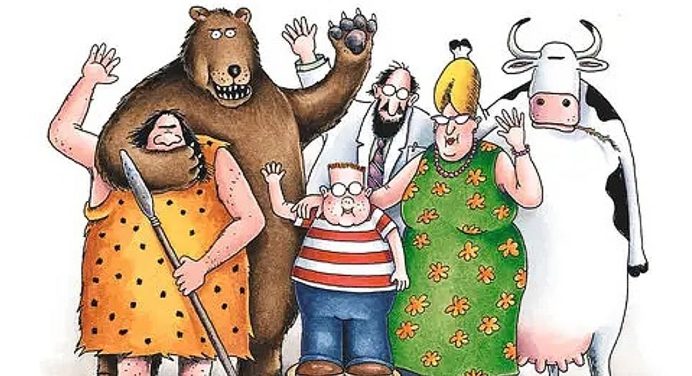Gary Larson’s iconic comic strip, “The Far Side,” delighted readers for fifteen years with its blend of humor, wit, and absurdity. Among its recurring motifs and settings, courtroom scenes stood out as some of the zaniest and most entertaining moments in Larson’s absurd world. Let’s take a whimsical journey through the evolution of Larson’s courtroom panels and explore the humor that made them unforgettable.
Looks Can Certainly Be Deceiving (January 18, 1980): In one of the earliest courtroom panels, Larson pokes fun at the idea of judging by appearances. A defense attorney points to his client, a simple smiley face, and asks the jury if it looks like a mass murderer. The juxtaposition of the innocent drawing with the serious accusation highlights Larson’s penchant for subverting expectations.
Some Breeds Of Dog Are More Loyal Than Others (October 16, 1980): Larson humorously explores the concept of loyalty as a dog testifies against its owner in court. The defendant’s nonchalant reaction adds to the absurdity, turning a classic human-canine dynamic into a legal conundrum.
This Trial Has Dragged Out All The Live Long Day (April 21, 1982): Larson cleverly references the folk song “I’ve Been Working on the Railroad” in this courtroom scene. By turning the lyrics into a crime scene and incorporating a banjo-wielding defendant, Larson injects humor into familiar cultural references.
This Cow Was Brought To Justice By Hubris, Not The Legal System (November 23, 1982): A cow’s startling confession disrupts the courtroom, showcasing Larson’s talent for anthropomorphism and absurdity. The cow’s motive adds an extra layer of humor, demonstrating Larson’s knack for unexpected twists.
Gary Larson’s Version Of A Celebrity Couple In Court (October 22, 1983): The comedic tension rises as Mr. Potato Head stands trial for attacking Mrs. Potato Head. Larson expertly blends the familiarity of the toy characters with the absurdity of a courtroom drama, creating a uniquely humorous scenario.
This Trial Is A Real Dog & Pony Show (September 28, 1985): In a courtroom full of cats, a dog faces charges of cat murder, highlighting Larson’s skill in creating absurd juxtapositions. The defendant’s futile defense adds to the comedic effect, making this panel a classic Far Side moment.
A Heated Exchange On The Witness Stand (February 20, 1984): An alligator’s pun-filled outburst steals the spotlight in this courtroom scene, showcasing Larson’s love for wordplay. The reptile’s defense adds a humorous twist to the typical courtroom drama, delighting readers with its cleverness.
Gary Larson Puts The Readers’ Childhood On Trial (September 28, 1992): Larson humorously reimagines the aftermath of the “Three Little Pigs” story in court. The attorney’s aggressive questioning adds comedic tension, turning a familiar nursery rhyme into a legal spectacle.
A Shock Last-Minute Witness Turns The Court Room Into A Media Spectacle (December 9, 1992): Larson satirizes the media’s obsession with courtroom drama in this panel, highlighting the absurdity of turning legal proceedings into entertainment. The playful use of nursery rhyme characters adds an extra layer of humor to the scene.
The Second Most Pivotal Monkey Trial In History (November 4, 1993): Larson concludes his courtroom antics with a hilarious dispute between a monkey and a man from the “Pop Goes the Weasel” rhyme. The absurdity of the situation, coupled with Larson’s witty dialogue, makes for a memorable Far Side finale.
FAQ
What made Gary Larson’s courtroom scenes in “The Far Side” stand out?
Larson’s courtroom scenes were notable for their blend of humor, wit, and absurdity. He often took familiar themes and twisted them in unexpected ways, creating comedic masterpieces that left readers laughing.
How did Larson use anthropomorphism in his courtroom panels?
Larson frequently anthropomorphized animals and inanimate objects in his comics, including in courtroom scenes. This added an extra layer of absurdity to the proceedings, as animals testified, confessed to crimes, and engaged in legal battles.
Did Larson incorporate cultural references into his courtroom panels?
Yes, Larson often incorporated cultural references, such as nursery rhymes and folk songs, into his courtroom scenes. He cleverly subverted familiar themes and phrases to create comedic tension and unexpected twists.
What was the appeal of Larson’s courtroom humor?
Larson’s courtroom humor appealed to readers because it combined familiarity with absurdity. By taking everyday situations and injecting them with his signature wit and humor, Larson created comic strips that were both relatable and laugh-out-loud funny.
Did Larson’s courtroom scenes evolve over time?
Yes, Larson’s courtroom scenes evolved over the years, reflecting changes in his artistic style and comedic sensibilities. While the themes remained consistent, Larson experimented with different scenarios and visual gags, keeping his comics fresh and engaging.
What made Larson’s courtroom scenes in “The Far Side” memorable?
Larson’s courtroom scenes were memorable for their clever wordplay, unexpected twists, and playful use of cultural references. They showcased Larson’s talent for blending humor with social commentary, creating comics that resonated with readers long after they were published.
Gary Larson’s courtroom panels in “The Far Side” exemplify his unique brand of humor, blending familiar themes with absurd twists to create unforgettable moments. Through clever wordplay, anthropomorphism, and cultural references, Larson transformed mundane legal proceedings into comedic masterpieces, leaving readers laughing for generations to come.
